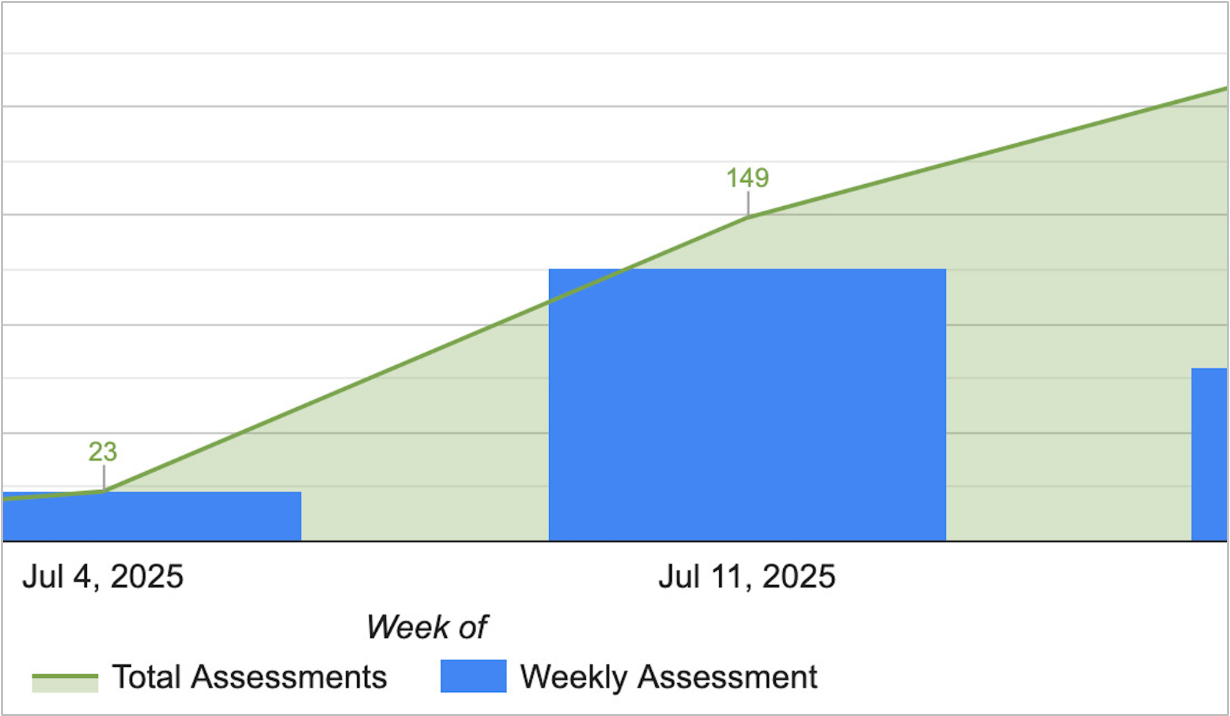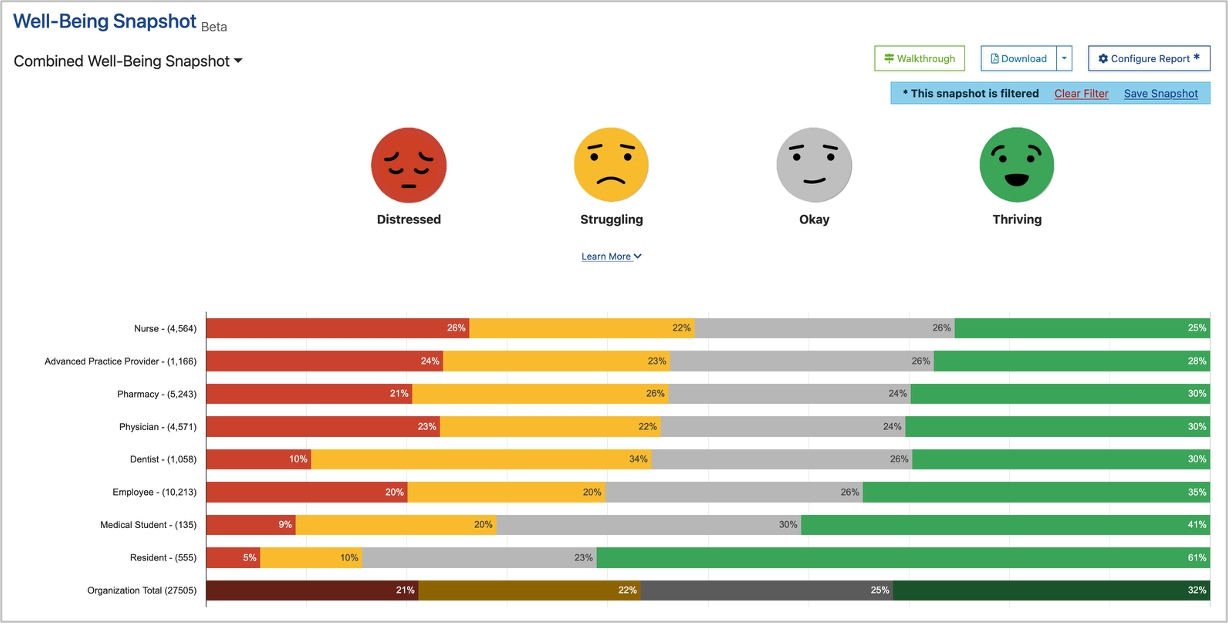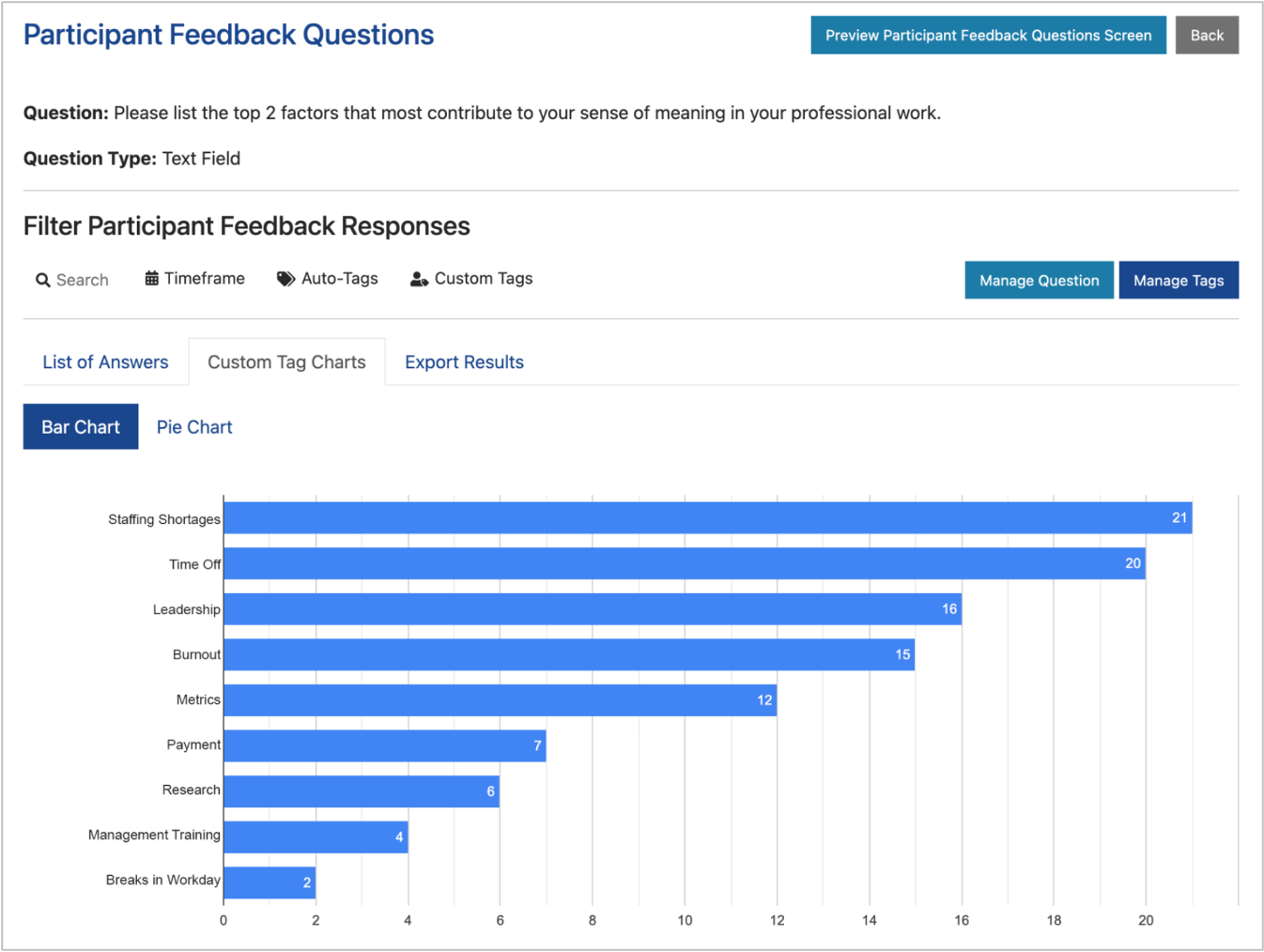Clinicians and the care they give represent the core of any healthcare organization. They treat patients, run hospital floors, act as the face of your mission, and are an essential point of connection between leadership, staff, and those seeking care. There is undeniably a lot on their plates, and they need proper organizational support.
An investment in clinician well-being equals an investment in your entire operation and a clear line can be drawn from their well-being to a more stable financial horizon.
Physician burnout incinerates bottom lines
In addition to the moral and ethical obligation to support staff well-being and mental health, it is also leaders’ financial responsibility to combat burnout and distress.
Physicians make money for healthcare organizations. A 2019 survey by Merritt Hawkins concluded that the average annual net revenue for all types of full-time physicians was $2,378,727. This study included net inpatient and outpatient revenue, hospital admissions, treatments, prescriptions, tests, and procedures performed or ordered.
Threats to physician wellness such as burnout can make them less effective at treating patients and keeping a strong momentum of workflow, however. A 2016 Mayo Clinic study found an association between physician burnout and changes in professional work effort. Another Mayo Clinic study from 2019 found that occupational distress and sleep-related impairment in physicians were associated with unsolicited patient complaints. The same was found for the adverse impact of work on physicians’ personal relationships, according to a 2022 Mayo Clinic study.
Losing a physician to burnout compounds the problem. It’s both a costly loss and an increasingly difficult position to replace.
According to a 2019 study on the costs attributable to physician burnout in the United States published in Annals of Internal Medicine, “at an organizational level, the annual economic cost associated with burnout related to turnover and reduced clinical hours is approximately $7,600 per employed physician each year.”
The U.S. The Bureau of Labor Statistics has projected that employment of physicians and surgeons will grow by 3% between 2021 to 2031, which is slower than expected growth of other occupations. Despite that limited growth, the bureau states that “about 23,800 openings for physicians and surgeons are projected each year, on average, over the decade. Most of those openings are expected to result from the need to replace workers who transfer to different occupations or exit the labor force, such as to retire.”
A recent report from the Well-Being Index on the economic cost of burnout covers the issue in more depth.
[RELATED: Economic Cost of Burnout Guide – The business case for investing in clinician well-being]
Burnout is not inevitable
The ill effects of burnout on healthcare organizations have been studied in the years since it became a widespread, well-known issue, and tools have been developed to combat its spread. The Well-Being Index was developed in coordination with doctors and researchers at Mayo Clinic as an accurate, efficient method of anonymously monitoring physician wellness and mental health. Monitoring means having the ability to intervene before distress can evolve into full-blown burnout.
Once you have the ability to assess the needs of your physicians, there are also proven paths for improving conditions for wellness. Taking steps to curb burnout in your organization can start small, and we’ve written previously on how organizations can fund wellness initiatives. Frameworks also exist to guide your organization’s approach to physician well-being, including structural roadmaps for how to best setup your well-being teams and communication channels.
[CASE STUDY: Creating a New Wellness Culture in a 21-State Health System]
The investment requires leadership to succeed
Investing in physician wellness means investing in wellness organization-wide. It’s one of the hidden benefits of embracing workplace well-being – performance in all departments improves with a supportive organizational infrastructure.
That does not happen without intentional, empathetic leadership. A 2023 study published by Plos found that leadership’s influence on the implementation of healthcare wellness programs was essential, and not in a sign-the-checks sense. As its authors wrote, “the study highlighted the need for workplace wellness programs to intentionally include leaders rather than only expect them to implement them.”
Another 2023 study, published by BMC Health Service Research found that “ongoing leadership development within a leadership ecosystem is crucial to realizing and sustaining organization-level
outcomes.”
Leadership’s role, ideally in the form of a Chief Wellness Officer, is to ensure the individual needs of physicians are being met. Some physicians may have lower odds of burnout if they feel their religious identity is accommodated in the workplace, as demonstrated by the findings of a 2023 study on career satisfaction and burnout among American Muslim physicians. Others may require more help with mental health or work/life balance issues. Studies like Physician Well-being 2.0: Where Are We and Where Are We Going? examine the issue in depth.
[RELATED: Organizational Wellness Structure Roadmap – A visual guide to help organize your teams]
Where to start?
When it comes to protecting your organization’s financial well-being, an investment in physician wellness is a crucial strategy to implement. Your doctors safeguard health and keep the lights on – making their well-being a priority safeguards a pivotal element of your organization.
So where should you begin? Reach out to our team of experts at the Well-Being Index. Our validated, evidence-based self-assessment tool already serves over 1,000 healthcare organizations with over 500,000 assessments completed to date. Regular completion of the assessment allows physicians to monitor and maintain their well-being, thus curbing the onset of burnout.
Citations:
Allan, J., Olcon, K., Everingham, R., Fox, M., Pai, P., Mackay, M., & Keevers, L. (2023). Leading wellness in healthcare: A qualitative study of leadership practices for wellness in hospital settings. PloS one, 18(7), e0285103. https://doi.org/10.1371/journal.pone.0285103
Bureau of Labor Statistics, U.S. Department of Labor, Occupational Outlook Handbook, Physicians and Surgeons, at https://www.bls.gov/ooh/healthcare/physicians-and-surgeons.htm (visited July 26, 2023).
Debets, M., Jansen, I., Lombarts, K., Kuijer-Siebelink, W., Kruijthof, K., Steinert, Y., Daams, J., & Silkens, M. (2023). Linking leadership development programs for physicians with organization-level outcomes: a realist review. BMC health services research, 23(1), 783. https://doi.org/10.1186/s12913-023-09811-y
Han, S., Shanafelt, T. D., Sinsky, C. A., Awad, K. M., Dyrbye, L. N., Fiscus, L. C., Trockel, M., & Goh, J. (2019). Estimating the Attributable Cost of Physician Burnout in the United States. Annals of internal medicine, 170(11), 784–790. https://doi.org/10.7326/M18-1422
Miller, Phillip. “New Survey Shows Physicians Are Key Revenue Generators for Hospitals.” Merrittt Hawkins, www.merritthawkins.com/news-and-insights/blog/healthcare-news-and-trends/new-survey-shows-physicians-are-key-revenue-generators-for-hospitals/.
From Mayo Clinic Proceedings:
Advancing Physician Well-Being
Trockel, Mickey et al.
Mayo Clinic Proceedings, Volume 95, Issue 11, 2350 – 2355
Assessment of the Relationship Between an Adverse Impact of Work on Physicians’ Personal
Relationships and Unsolicited Patient Complaints
Trockel, Joshua et al.
Mayo Clinic Proceedings, Volume 97, Issue 9, 1680 – 1691
Association of Occupational Distress and Sleep-Related Impairment in Physicians With Unsolicited
Patient Complaints
Welle, Dana et al.
Mayo Clinic Proceedings, Volume 95, Issue 4, 719 – 726
Longitudinal Study Evaluating the Association Between Physician Burnout and Changes in Professional Work Effort
Shanafelt, Tait D. et al.
Mayo Clinic Proceedings, Volume 91, Issue 4, 422 – 431







